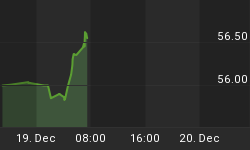Last week, the Labor Department reported that 108,000 jobs were created in December. This was about half of what economists expected. However, the number of jobs created in November was revised up by 90,000 to 305,000, which was the largest number since April 2004. This report also perpetuated the "Goldilocks" scenario by indicating that the economy has recently slowed, but is in overall good health. This would allow the Fed to stop raising rates sooner rather than later. It should be a little troubling to economists that average hourly earnings increased 3.1%, the fastest pace since early 2003.
Last week, the ISM reported that its non-manufacturing survey increased 1.3 points to 59.8. The increase was led by increases in new orders (up 2.4 points to 61.9) and in export orders (up 4.5 points to 61.5). Prices fell 4.7 points to 69.5. The prices component has declined to levels it was prior to the hurricanes. That seems to be a theme in the economic data over the past month. Most economic indicators have reverted back to the levels of this summer. If most of the disruptions from the hurricanes have subsided, it will make it much easier to gauge the strength of the economy.
A few companies have already reported fourth quarter earnings, but most will not until the third week of January. Higher costs will likely pressure earnings for the industrial sector. Alcoa announced fourth quarter earnings that were lower than Wall Street forecasts. Higher aluminum prices were not enough to offset higher costs. The company stated that, "Entering 2005, we anticipated significant pressures from rising input, energy costs and other cost inflation, but actual increases were even higher." The company thinks that these costs have plateaued, but does not expect costs to be lower in 2006. On the conference call, management discussed the long-term forecast for aluminum demand. It said over the next 15 years, aluminum consumption should double with most of the growth coming from Brazil, Russia, India, China, and Korea. This will require 80 new smelters or 5 per year. For prospective, Alcoa currently has 26 smelters. In 2006, Alcoa expects to spend $2.5 - $3 billion in capital expenditures.
Phelps Dodge announced that fourth quarter earnings would be lower than analysts estimates. Output was 37 million pounds lower than the company forecasted and the company hedged copper prices to lock in profit. Unfortunately, for the company, copper prices continued to soar, costing the company about $200 million. The company has hedged about 50% of its production over the next two years, locking in $0.95. To help pay for the hedge the company capped 25% of production at $1.63 this year and $2.098 next year. DuPont revealed that fourth quarter earnings would 10 cents per share, about half of what the company expected at the beginning of the quarter. The company blames plant disruptions caused by the hurricanes along with higher energy costs.
Retailers reported December sales results last week that were generally inline with estimates. The ICSC reported that December same store sales increased 3.2%. This was the slowest pace since May. The holiday season was +3.5%, which was at the high end of the trade group's forecast. This was substantially better than last year's results, up 2.3%. Luxury was the best performing segment, up 6.4% while furniture sales lagged, down 3.9%. Discount stores increased sales by only 2.3%. Most of the weakness was due to Wal-Mart. The nation's largest retailer reported that its same store sales growth was 2.2% in December. This was the smallest gain in December sales since 2000. Additionally, CSFB issued a research note with the results of its pricing survey. It found that Target had the lowest prices in December for the first time since the survey was started 19 months ago. For the full year, chain store sales increased 3.7%. Most analysts are expecting January sales to be strong based on the growth of gift cards, and its off to a decent start. Retail sales rebounded during the first week of the year, rising 3.7% compared to last year.
Gap was one of the worse performing retailers. Same store sales dropped 9%, much worse than the 3.8% decline analysts forecasted. Even with the lackluster results, the company maintained its fourth quarter earnings guidance. While sales were lighter than expected, the company to have higher margins due to have less discounts. So many retailers discussed having more new merchandise available immediately after Christmas to lure shoppers in. This might prove to be a very good strategy, especially with the unseasonably warm weather across the nation. The downside to the strategy is the possibility of pulling forward sales from March and April.
During fourth quarter conference calls companies will be discussing their views for 2006. Companies usually try to paint a rosy picture. Industrial companies will likely be upbeat due to the strong global economy and will be optimistic after withstanding a historic increase in pricing, especially energy prices. However, it is still likely that input costs will continue to increase even if commodity prices stabilize. Companies will continue to pass through price increases, plus hedges will roll off, exposing companies to price increases.















